- Exam & Cleaning
- Cosmetic Dentistry
- Root Canal Treatment
- Crowns/Bridges
- Implants
- Dentures
- Periodontics
- Orthodontics
Exam & Cleaning
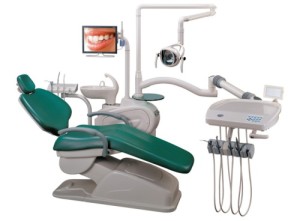 A comprehensive dental exam and x-rays are crucial for oral health, and will be performed by your dentist at your initial visit and recall visits (usually every 6 months). Comprehensive dental exam include: 1- Diagnostic x-rays (to check for decay, abscess, fractures, tumors, cysts, bone loss, jaw or TMJ, alignment of teeth, previous restorations, etc.), 2- Oral cancer screening (to check the face, lips, tongue, cheek, palate, throat, tissues, and gums for any signs of oral cancer.), 3- Gum disease evaluation (to check the gums and bone around the teeth for any signs of periodontal disease), 4- Examination of tooth decay (all tooth surfaces will be checked for decay), 5- Examination of existing restorations (to check conditions of current fillings, veneers, crowns and bridges, implants, dentures, etc).
A comprehensive dental exam and x-rays are crucial for oral health, and will be performed by your dentist at your initial visit and recall visits (usually every 6 months). Comprehensive dental exam include: 1- Diagnostic x-rays (to check for decay, abscess, fractures, tumors, cysts, bone loss, jaw or TMJ, alignment of teeth, previous restorations, etc.), 2- Oral cancer screening (to check the face, lips, tongue, cheek, palate, throat, tissues, and gums for any signs of oral cancer.), 3- Gum disease evaluation (to check the gums and bone around the teeth for any signs of periodontal disease), 4- Examination of tooth decay (all tooth surfaces will be checked for decay), 5- Examination of existing restorations (to check conditions of current fillings, veneers, crowns and bridges, implants, dentures, etc).Professional dental cleaning, also called dental prophylaxis, is the most basic and important part of oral health maintenance, and will be performed by your dentists or hygienists, recommended every 3 to 6 months.
Dental cleaning usually takes less than 30 minutes (time varies depending on how much “build up” each patient has), and it is necessary to remove plaque, calculus (tartar) around teeth and gum areas. Plaque is a sticky, almost invisible film that forms on the teeth even with brushing, flossing, and rinsing at home. It is a growing colony of living bacteria, food debris, and saliva. The bacteria produce toxins that can inflame the gums and bones around teeth. Calculus is hardened plaque that has been left on the tooth for some time and is now firmly attached to the tooth surface. Inflammation is a sign of gum disease and the main symptoms are sore, swollen, bleeding gums.
Calculus forms both above and below the gum line, and it may cause an inflammatory process which can damage the gums, bone and even affect the blood vessels and the heart. They can only be removed with special dental instruments such as an ultrasonic cavitron and dental scalers.
After each cleaning, teeth “polishing” is completed in order to remove any remaining stains/plaques, and create a clean and smooth teeth surface.
Cosmetic Dentistry
Composite (Tooth Colored) Fillings
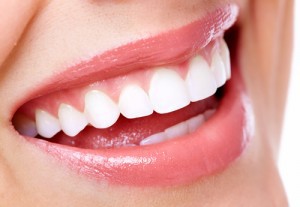 Composite (tooth colored) fillings are used to repair a tooth that is affected by decay, cracks, fractures, trauma, etc. Composites are the most widely used restorative material today, and usually placed in one appointment. The decayed or affected portion of the tooth will be cleaned and removed after proper anesthesia, and then the cosmetic composite filling will be precisely placed, shaped, and polished, restoring your tooth to its original shape, color, and function.
Composite (tooth colored) fillings are used to repair a tooth that is affected by decay, cracks, fractures, trauma, etc. Composites are the most widely used restorative material today, and usually placed in one appointment. The decayed or affected portion of the tooth will be cleaned and removed after proper anesthesia, and then the cosmetic composite filling will be precisely placed, shaped, and polished, restoring your tooth to its original shape, color, and function.Since composite fillings are manufactured in variety of different teeth colors, they can be closely matched to the color of existing teeth. They also bond to the teeth so that they strengthen the teeth surfaces and will last many years, giving you a very durable, beautiful smile.
Onlays/Inlays
An inlay or onlay is another great way to restore a decayed, damaged, cracked, or fractured tooth. An inlay is similar to a filling, and it lies within the cusps (bumps) on the chewing surface of your tooth. An onlay is larger than an inlay, and it replaces one or more decayed or damaged cusps. Both inlay and onlay restorations are usually bigger than a filling and smaller than a crown. It is made by a professional dental laboratory, and bonded or cemented into place, similar to that of a crown. Inlay and onlay restorations are made of resin-composite material, gold, or tooth-colored porcelain. Porcelain onlays are popular because they resemble your natural tooth. An onlay is sometimes also referred to as a partial crown. Porcelain onlays are permanently cemented onto the tooth by your dentist.
Porcelain Veneers
Veneers are very thin pieces of durable, tooth colored/shaped porcelain that are custom made by a professional dental laboratory, and bonded onto the front of teeth to create a beautiful and attractive smile. Veneers can be used to treat and repair teeth that are chipped, crooked, misshaped, discolored, stained, too small, too big, and dramatically reshape your teeth and smile. They are very durable, giving you an attractive, uniform, long lasting smile.
Teeth Whitening
Teeth become discolored and stained for a number of reasons including food/drinks that you consume, fluorosis (excessive fluoridation during tooth development), normal wear of outer tooth layer, and medications (tetracycline, etc.). Tooth whitening (or “bleaching”) is a simple, safe, non-invasive dental treatment used to change the color of natural tooth enamel and is an ideal way to enhance the beauty of your smile.
Tooth whitening (either by take-home kit or in-office methods) uses bleaching ingredients to effectively lift the stains from enamel surfaces to create an attractive, whiter smile.
Root Canal Treatment
 Root canal is a treatment to repair and save a badly damaged or infected tooth instead of removing it. Unless the tooth is completely calcified, all of our teeth have thin strands of dental nerves within the canals of each root, and they can be damaged or infected and become painful by different reasons including decay, trauma, fracture, gum condition, and previous large/deep restorations.
Root canal is a treatment to repair and save a badly damaged or infected tooth instead of removing it. Unless the tooth is completely calcified, all of our teeth have thin strands of dental nerves within the canals of each root, and they can be damaged or infected and become painful by different reasons including decay, trauma, fracture, gum condition, and previous large/deep restorations.Root canal treatment is designed to save such damaged teeth by cleaning the infected/diseased nerves, disinfecting, filling all the canals, and then placing a crown which seals/protects the tooth and fully restore the function of the tooth. With advances in dental technology and local anesthetics, most people hardly have any pain during a root canal. Root canal alternatives include extracting the damaged tooth and replacing it with a dental implant, bridge or removable partial denture.
Crowns/Bridges
Crowns
 A crown is a type of dental restoration which completely “caps” or encircles a tooth or dental implant. Besides protecting and strengthening a damaged tooth, a crown can be used to improve its appearance, shape, and alignment.
A crown is a type of dental restoration which completely “caps” or encircles a tooth or dental implant. Besides protecting and strengthening a damaged tooth, a crown can be used to improve its appearance, shape, and alignment.Crowns are often needed in different situations including, when a large filling is not sufficient enough to restore a decayed or broken tooth, to act as crown abutments for a bridge, to cover dental implants, to cover discolored teeth (cosmetic), to cover a tooth that had a root canal, etc. They are typically bonded to the tooth using a permanent crown cement.
Bridges
A fixed bridge may be recommended if you are missing one or more teeth with remaining teeth present next to the missing teeth. Gaps untreated and left by missing teeth eventually cause the surrounding teeth to rotate/shift into the empty spaces, and opposing teeth to “supra-erupt” and eventually become loose. Subsequently, it can result in a bad occlusion/bite, damage/fracture of remaining teeth, gum disease, and/or temporomandibular joint (TMJ) disorders.
Bridge restorations are commonly used to replace one or more missing teeth, and they span the space where the teeth are missing. Bridges are cemented to the natural teeth or implants surrounding the empty space. These teeth or implants, called abutments, serve as anchors for the bridge. A replacement tooth, called a pontic, is attached to the crowns that cover the abutments.
Materials that are used to fabricate crowns and bridges include porcelain, ceramic, zirconia, gold and metal alloys. Porcelain, porcelain fused to metal casting, and ceramic can be matched to the color/shade of natural teeth and create a bright and attractive smile.
Implants
 A dental implant is a small titanium screw that serves as the replacement for the root portion of a missing natural tooth, and is designed to provide the look, feel, and function as in a natural tooth. Dental implants can be placed in either the upper or lower jaws, where teeth are missing. Due to the biocompatible properties of titanium, a dental implant fuses with the bone (integration), and becomes a good anchor for the replacement tooth. Dental implants can be used in solutions for replacing single or multiple missing teeth, and can also be used as strong support for partial or complete dentures, known as an overdenture.
A dental implant is a small titanium screw that serves as the replacement for the root portion of a missing natural tooth, and is designed to provide the look, feel, and function as in a natural tooth. Dental implants can be placed in either the upper or lower jaws, where teeth are missing. Due to the biocompatible properties of titanium, a dental implant fuses with the bone (integration), and becomes a good anchor for the replacement tooth. Dental implants can be used in solutions for replacing single or multiple missing teeth, and can also be used as strong support for partial or complete dentures, known as an overdenture.There are many advantages when replacing missing teeth with implants. When you lose the entire tooth (crown and root), shrinkage of the jawbone will start causing bone weakness/resorption, teeth shifting, occlusion/bite change, and even make your face to look older. Dental implants can stop this process by restoring the missing teeth to the closest natural form/shape/function. With traditional dental bridges, teeth adjacent to missing teeth are normally ground or shaped down to be used as anchors or abutments for a dental bridge. Dental implants often eliminate the need to modify healthy teeth so that they preserve adjacent natural teeth. There are no loose parts to worry about losing. The dental implant is stable and comfortable. No adjustment is needed after placement. Normally, it will serve its owner for life!
Dental implant-supported replacement teeth look, feel and function like natural teeth. This means that you can eat and drink whatever you choose. But most importantly, dental implants often improve the quality of life in a very concrete way. People who have felt embarrassed and worried because of their tooth problems are often overwhelmed by what new permanent teeth can do for their self-esteem. When dental implants are used in combination with modern restorative dentistry, their appearance, comfort and function are very likely to exceed your expectations.
Dentures
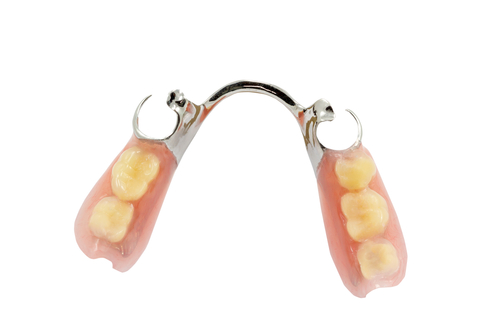 A denture is a removable dental appliance used as a replacement for missing teeth and surrounding tissue. They are made to closely resemble your natural teeth and may even enhance your smile. There are two types of dentures - complete and partial. Complete “full” dentures are used when all of the teeth are missing, while partial dentures are used when some natural teeth remain. A partial denture not only fills in the spaces created by missing teeth, it prevents other teeth from shifting.
A denture is a removable dental appliance used as a replacement for missing teeth and surrounding tissue. They are made to closely resemble your natural teeth and may even enhance your smile. There are two types of dentures - complete and partial. Complete “full” dentures are used when all of the teeth are missing, while partial dentures are used when some natural teeth remain. A partial denture not only fills in the spaces created by missing teeth, it prevents other teeth from shifting.A complete denture may be either “conventional” or “immediate.” A conventional type is made after the teeth have been removed and the gum tissue has healed, usually taking 4 to 6 weeks. During this time the patient will go without teeth. Immediate dentures are made in advance and immediately placed after the teeth are removed, thus preventing the patient from having to be without teeth during the healing process. Once the tissues shrink and heal, adjustments will have to be made such as a reline.
Dentures are very durable appliances and will last many years, but may have to be remade, repaired, or readjusted due to normal wear.
Periodontics
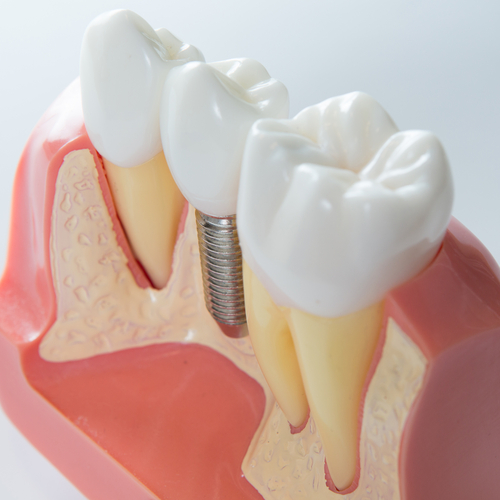 Periodontics is a very important dental field which specializes in the soft tissues of the mouth and the underlying jawbone which supports the teeth, called a periodontium. The periodontist, who specializes in this field, is mainly concerned with preventing the onset of gum disease (periodontal disease), diagnosing conditions affecting the gums and jawbone, and treating gingivitis, periodontitis and bone loss. Periodontal disease is a progressive condition and the leading cause of tooth loss among adults in the developed world.
Periodontics is a very important dental field which specializes in the soft tissues of the mouth and the underlying jawbone which supports the teeth, called a periodontium. The periodontist, who specializes in this field, is mainly concerned with preventing the onset of gum disease (periodontal disease), diagnosing conditions affecting the gums and jawbone, and treating gingivitis, periodontitis and bone loss. Periodontal disease is a progressive condition and the leading cause of tooth loss among adults in the developed world.The periodontist is able to treat mild, moderate and advanced gum disease by first addressing the bacterial infection at the root of the problem, providing periodontal treatment, then providing information/education on good oral hygiene and effective ways to clean your teeth. The most common conditions treated by the periodontist include: Gingivitis (mild inflammation of the gums which may or may not be signified by pain and bleeding), Mild/moderate periodontitis (the pockets between the teeth and the soft tissues are measured to be between 4-6mm it is classified as moderate periodontitis or gum disease), Advanced periodontitis (When the pockets between the teeth and the soft tissues in general exceed 6mm in depth, significant bone loss may occur; causing shifting or loss of teeth), and/or Missing teeth (when teeth are missing as a result of bone loss, the periodontist can graft bone at the site, if needed, and place a dental implant to eventually restore function).
Osteoplasty (hard tissue recontouring), gingivoplasty (soft tissue recontouring), teeth removal, bone grafting, deep pocket treatments, and crown lengthening are among some other periodontic treatments.
Orthodontics
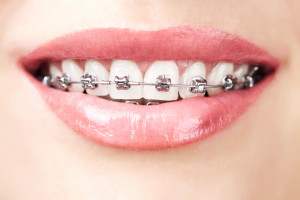 Orthodontics is a specialty in dentistry that deals with diagnosis, prevention and treatment of teeth and/or jaws that are in mal-position or malocclusion (crowded/crooked teeth and incorrect bite). Cosmetics aside, improperly positioned teeth are harder to clean and can lead to tooth decay and periodontal disease. In some instances, because of the incorrect bite, it puts strain on the facial muscles and may cause TMJ dysfunction/pain.
Orthodontics is a specialty in dentistry that deals with diagnosis, prevention and treatment of teeth and/or jaws that are in mal-position or malocclusion (crowded/crooked teeth and incorrect bite). Cosmetics aside, improperly positioned teeth are harder to clean and can lead to tooth decay and periodontal disease. In some instances, because of the incorrect bite, it puts strain on the facial muscles and may cause TMJ dysfunction/pain.In comprehensive orthodontic treatments, the most common method used are brackets (braces) that are bonded and fixed on front of teeth, and bands that are fixed around teeth and used as anchors. The wires are then inserted into the brackets and attached to the bands. This interaction is a common method used to move and set teeth into the desired position, and ultimately straighten teeth, improve the patient’s smile and oral health.
Another popular way of moving teeth to the desired position is to use clear aligners or better known as Invisalign. Aligners are comfortable, nearly invisible and can easily be cleaned and removed for eating, brushing and flossing. A set of serial aligners will gradually shift and move teeth to the proper position. The custom aligners are smooth, easy to wear, virtually invisible and it is very popular for patients of all ages who want to look and feel good about their smile.





